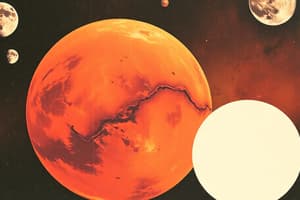Podcast
Questions and Answers
Qual das seguintes características da superfície de Marte é verdadeira?
Qual das seguintes características da superfície de Marte é verdadeira?
- A superfície é feita de basalto típico, como na Terra (correct)
- A superfície é densa, com uma camada de ferro óxido (III).
- A superfície é feita de água líquida
- A superfície tem trilhos lineares, como os rios na Terra
Flashcards are hidden until you start studying
Study Notes
-
Mars is a rocky planet with a thin atmosphere.
-
It has features on its surface that are similar to both the craters on the moon and the volcanoes on Earth.
-
The planet's rotational and seasonal cycles are similar to those on Earth.
-
The planet has two known moons, Fobos and Deimos.
-
The planet has a metal core with a dense outer layer of materials that are less dense.
-
The planet's average thickness is 50 kilometers, with a maximum thickness of 125 kilometers.
-
The planet's surface is made up of a layer of rock that is 50 kilometers thick, with a maximum thickness of 125 kilometers.
-
The planet's surface is less dense than Earth's surface.
-
Marte is a planet made mostly of rocks and minerals containing silicon and oxygen.
-
The surface of Mars is made up of basalto típico, which is also found on Earth, but some parts are richer in sílica than basalto and can be similar to the rocks of the Andes or glass on Earth.
-
Low-altitude areas have concentrations of plagioclásios, which are higher than normal near the north pole.
-
Higher elevations to the south contain detectable amounts of piroxênios with a high level of calcium.
-
Locations located near the poles contain concentrations of hematite and olivine.
-
Most of the surface is covered by a thin layer of iron oxide (III) of fine texture.
-
During the formation of the Solar System, Mars was created as a result of a statistical process of erosion from the protoplanet orbiting the Sun.
-
Martian minerals have chemical properties that are due to its position in the Solar System. Elements with lower points of evaporation, like chlorine, phosphorus and helium, are more common on Mars than on Earth. These elements may have been removed from close to the Sun by solar wind.
-
After the formation of planets, all were subject to an "intense late bombardment". About 60% of the surface of Mars has evidence of impacts from this time period.
-
There is evidence of an enormous impact basin in the north pole covering 10,600 km by 8,500 km, which is four times the size of the Aitken Basin on the Moon. This theory suggests that Mars was hit by a body the size of Pluto about four billion years ago, creating the gentle Polar North Basin.
-
The surface of Mars is composed of a mixture of rock and ice.
-
The surface of Mars is very dry and does not have the water necessary for life.
-
The surface of Mars has active geological cycles that were once present but no longer exist.
-
Water may exist underground on Mars, but it would be very difficult to access because of the weaker atmospheric pressure.
-
The two polar ice caps on Mars may be made mostly of water.
-
Radar data has revealed the presence of large amounts of ice at middle and high latitudes.
-
Water may be present on Mars in liquid form during warm months.
-
It is believed that large quantities of frozen water are trapped within the thick Martian ice cap.
-
radar data from the Mars Express and Mars Reconnaissance Orbiter show large amounts of ice in both polar regions (July 2005) [52][57] and in middle latitudes (November 2008) [53]
-
The Phoenix lander retrieved water samples from the Martian surface in July 2008.
-
Visible relief on Mars suggests that water in liquid form once covered the surface of the planet.
-
Large linear strips of land washed clean are known as drainage channels.
-
It is believed that these channels were formed as a result of a catastrophic water release from subterranean reservoirs, although there are theories that some of these structures may have resulted from glaciers or lava.
-
Subsurface water and groundwater flows may play an important supplementary role in some of these networks, but precipitation was most likely the main cause of formation in almost all cases.
-
Along crater walls and narrow valleys, there are thousands of geographic features that resemble terrestrial water courses.
-
These features are likely the result of water flowing across the surface in the early history of the planet.
-
Other geological features, such as deltas and alpine glaciers, are preserved in many Martian craters.
-
Conditions on Mars must have been warmer and moister in some interval or intervals in the past in order for lakes to be present in a significant proportion of the surface, for which there is also geological evidence, mineralogical, sedimentological, and geomorphological evidence independent of water.
Studying That Suits You
Use AI to generate personalized quizzes and flashcards to suit your learning preferences.




